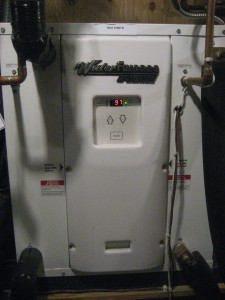“Geothermal” is a bit of a misnomer, because true geothermal works only in specific geographical places where there are hot spots in the ground. Most people who use this term are referring to ground-source heat pumps, which take the relative heat and cooling from the earth to heat and cool the home.

The easiest way to think about it is as a heat exchange system that uses the earth’s constant 50-55 degree temperature to help you get to your desired home temperature, which is usually between 68 and 72 degrees. In the hot summer months, think about that outdoor air-conditioning compressor that has to work so hard to bring in 90-100 degree air and cool it down. Instead, the ground source heat pump brings in 50 degree water and passes it over air to cool it. And there is no outdoor air-conditioning compressor – a definite benefit.
The system itself involves drilling either deep into the ground (in our case, we have ten loops under the driveway that go down 120 feet) or horizontally underground. Horizontal installation is usually less expensive, but requires more land where no tree roots could interfere.as to work so hard to bring in 90-100 degree air and cool it down. Instead, the ground source heat pump brings in 50 degree water and passes it over air to cool it. And there is no outdoor air-conditioning compressor – a definite benefit.
Ground source heat pumps, since they are hydronic systems, work particularly well with hydronic in-floor heating systems, because a water-to-water transfer of heat in simply more efficient.
Costs:
The cost can be an incremental 20%-30% on a whole house system. Currently, though, there is a federal tax credit that gives you a 30% rebate off the total cost, including labor and installation. The cost to operate it is just the cost of electricity to run the heat pump. Maintenance is slightly less than a standard system, because there is no outdoor air conditioning compressor to clean.
Benefits:
The efficiency ratio is 3:1 — which means you should be using about 1/3 the energy to heat and cool your home. Nothing else can possibly have more than a 1:1 efficiency ratio. That does not necessarily translate into a utility bill that is 1/3 the cost, because your home uses energy for other things like lighting and appliances. If heating and cooling your home is 42% of your utility bill, which is about average, then you can expect to save 2/3 of that cost on an annual basis — thereby reducing your total utility bills (gas and electric) by 28%. So, if your utility bills are $10,000/year, you can expect that to go down to $7,200, saving $2,800/year.
Cost/Benefit Analysis:
Assume a new system for a newly constructed house: if a geothermal system costs and additional $28,000 more (with a 30% federal tax credit, which brings it down to close to $20,000), and you save $2,800/year, the system basically pays for itself within 7 years. Is that a quick enough payback? That depends on your time horizon, but I would venture to guess that it is enough — and it should increase the value of the home.
From an environmental standpoint, you do use a lot of electricity to run the pump. If you get all of your electricity from coal, that’s not great from an environmental stand point. But it depends on what you are comparing it to. Most new homes in our area would be using natural gas for heating the home and electricity for cooling the home. Though cleaner than coal, natural gas is still a fossil fuel and still pollutes. In my mind, electricity generation can keep getting cleaner and cleaner (solar and wind, e.g,), and natural gas is, again, a fossil fuel. When I did my analysis for our home, geothermal was so much more efficient that even when assuming our electricity was 70% generated by coal, the net effect was significantly less pollution.
For us, we plan on being in our home longer than 7 years, and the annual reduction in energy use and corresponding pollution makes it an investment well worth consideration. For remodels, it might not make sense financially unless you are planning on replacing your furnace anyway.
